© 2014 BOB SKIDMORE ALL RIGHTS RESERVED
BOB SKIDMORE
CORRESPONDENT
In this high tech world it seems that everything requires a password. It
ranges from a mix of upper and lower case letters, symbols, numerical digits to
a minimum number of suggested character combinations. Not only is this complex,
how can you possibly remember them all, and still be expected to change them frequently?
What’s a person to do?
So, here are some dos and don’ts: Don’t use the same password for
different sites. Don’t use family names, pet names, hometowns, special
memorable dates or any other information that may be available about you on
line. Don’t save passwords or use “remember me” on a public computer since the
next user could have access to it. Don’t reuse old passwords. Don’t use common
choices such as 1234, the word password or your name. Do use longer passwords
made up of numerous characters. Characters should contain upper and lower case
letters, numbers and a various combination of symbols. Mixing them in the
middle of a word also makes your password more difficult to hack. Use the
number 0 in place of O and $ in place of S. An example would be Mind572iNg~0Pen6431Ca$h.
These combinations will make hacking much more tedious and time consuming.
“Longer is stronger” should be the goal!
Now that you’ve created all these long and strong passwords, how do you
remember them all? Since nobody else has access on my home computer, I use a Rolodex
system. I created a label file called Passwords
on my DYMO label program. I include the web address, ID, password, security
questions/answers and any other useful information. Since this is on my
computer, I make sure that the file, not the program, is kept on a flash drive
or memory stick and not permanently on the computer. This allows you to keep
both the Rolodex and flash drive under lock and key, if necessary. Updates or
changes are easy since once the change is made you simply print out a new label
for your Rolodex. This method makes for a ledgeable and accurate record of your
ID’s and passwords.
In the case of mobile devices, such as iPhones and iPads, I use an app
called Password Manager that is password protected and is kept only in the memory
of my device. Since the introduction of this program several years ago, a wide
variety of similar apps are now available for various brands of smartphones and
tablets. Make sure that the program you select is password protectable so
anyone using your device will not have access to it. Numerous password creation
apps are also available that randomly create unique password combinations.
Web-based options that create and store your encrypted passwords and
allow you to automatically access them are also available. My hesitation with
using any “cloud based” storage of passwords or, for that matter, files, is
that I don’t want to entrust such sensitive information with a third party. No
matter how secure they claim to be, access by someone else may be possible. In
addition, the possibility of requiring a higher or additional fee to access
your information could always be an unwelcome surprise at some later date when
you desperately need it. Buyer, always beware!
Graphic credit: picgifs
Bob
Skidmore is a freelance writer, who may be contacted at bob.thegadgeteer.skidmore@gmail.com, or followed at twitter.com/bskidmore for the latest gadget industry news. He does not represent,
make any legality of use claims, or endorse any of the products he reviews. His
opinions are solely his points of view and not those of the manufacturer. The
manufacturer generally supplies products at no cost for the articles and no
other compensation is received. THE GADGETEER is highly selective as to
products he feels worthy of review so as not to waste the reader’s time, thus
the reason for many superior ratings. Some
information for this article may be gathered from various news sources
available to the author.
##


